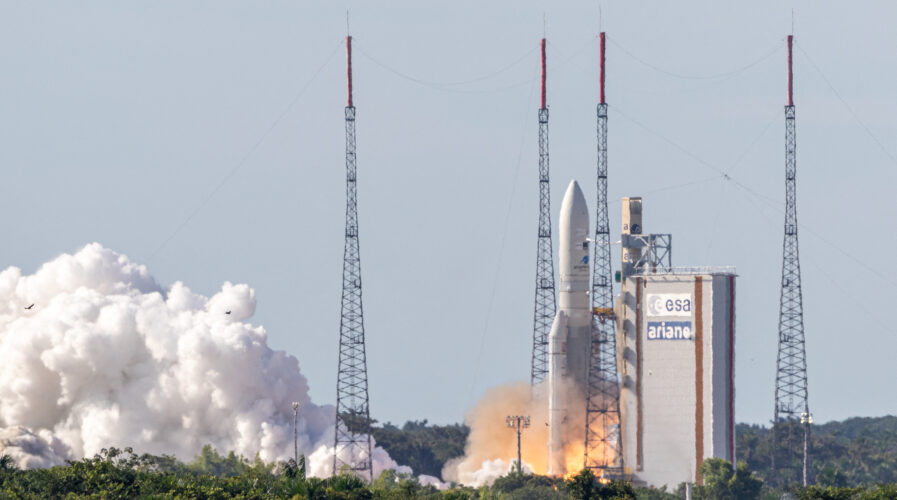
(Photo by jody amiet / AFP)
A unified satellite network to evolve connectivity on the planet
Everyone is excited about satellites, but which type of satellite really matter to them? Can a satellite network improve use cases around the world?
Satellites have been around for more than half a century now, with Russia’s Sputnik 1 being the first satellite launched way back in 1957. Since then, the technology has evolved tremendously with newer and more sophisticated satellites making their way to space.
Today nearly 7000 satellites are orbiting the planet and the number is expected to grow with more launches being conducted. Apart from communications and military intelligence purposes, the use cases of satellites have also increased.
There are now three types of satellites orbiting the world, each with its own unique purpose. The first is low earth orbit satellites or more commonly known as LEO satellites. LEO satellites are located at an area in space below the altitude of 2000km. These satellites are mostly used for communications, military reconnaissance, and such.
However, LEO satellites are now gaining popularity thanks to a certain Elon Musk and his Starlink satellites. The Starlink satellite is an LEO satellite that can be used to provide fast, reliable internet to populations with little or no connectivity. There are now more than 2200 Starlink satellites in orbit, providing internet so certain parts of the world, including Ukraine, where Musk ensured internet connectivity via Starlink during the Russian invasion.
At the same time, Amazon is also competing with Elon Musk’s SpaceX by beaming satellite broadband to customers worldwide. Amazon has already secured rocket launch agreements with partners in the United States and Europe. Project Kuiper will see a constellation of 3,236 satellites launched into LEO under deals signed with France’s Arianespace, US firm United Launch Alliance (ULA), and Blue Origin.
LEO satellites are also being used for perfecting autonomous vehicles. Recently, Geespace, a wholly-owned subsidiary of Geely Technology Group and China’s first privately-owned developer, operator, and mass producer of low-orbit commercial satellites, has successfully launched its first nine satellites into low earth orbit from the Xichang Satellite Launch Center.
Geespace’s GeeSAT-1 are the first modular, high-resilience, high-performance, mass-produced low-orbit satellites in China. They will provide centimeter-accurate precise positioning and connectivity support for use by automotive brands in the Geely Holding portfolio, enabling true, safe autonomous driving that will connect vehicles with vehicles and infrastructure with vehicles to realize true autonomous driving.
After LEO, the orbit is filled with medium earth orbit satellites or MEO satellites. MEO satellites orbit the Earth between 2000km to 35,786km. All satellites in MEO have an orbital period of fewer than 24 hours, with a minimum period of about two hours. These satellites are mostly used for GPS and other navigation applications. Reports also show that MEO constellations are being used to deliver low-latency, high-bandwidth data connectivity to service providers, government agencies, and commercial enterprises.
High-earth orbit satellites are the game changers in the industry. While LEO and MEO satellites ensure connectivity and such, HEO satellites keep the world going. Located furthest from Earth, satellites in HEO are suited for communications, satellite radio, remote sensing, and other applications. This includes radar communication in airplanes and ships.
So how do enterprises make the most of a satellite network?

Terry Bleakley, RVP, Asia Pacific at Intelsat
This is where Intelsat comes in. While there are three main types of satellites in orbit, connecting them and leveraging them on use cases is no easy task. However, Intelsat is able to do that and provide a unified global network that secures coverage over land, air, and sea as well as for mission-critical operations.
As the operator of the world’s largest integrated satellite and terrestrial network and leading provider of inflight connectivity, Intelsat recently announced that there are now more than 10,000 vessels operating on its award-winning FlexMaritime service.
In April 2022, Intelsat announced its latest service office, Cloud Connect Media, a connectivity solution that provides programmers with secure access between the IntelsatOne Media Network and AWS. The collaboration can provide Intelsat media customers a more efficient way to connect to their playout, video editing, and additional resources they use in the cloud while still accessing the IntelsatOne media network.
According to Terry Bleakley, RVP, the Asia Pacific at Intelsat, while the hype on LEO satellites is high, the reality is, that there is a need for a unified global network to ensure seamless connectivity, not just for the internet but for almost everything done today. This includes flight radars, GPS, cloud services, and such. A unified network enables businesses to have the best of everything and not worry about shortcomings in the future.
For now, as the world moves towards faster internet speeds and low latency, satellites will only continue to be a key area in which industries will invest in. The only question now is, will they all join the LEO hype or look towards leveraging a unified satellite network.
READ MORE
- Strategies for Democratizing GenAI
- The criticality of endpoint management in cybersecurity and operations
- Ethical AI: The renewed importance of safeguarding data and customer privacy in Generative AI applications
- How Japan balances AI-driven opportunities with cybersecurity needs
- Deploying SASE: Benchmarking your approach


